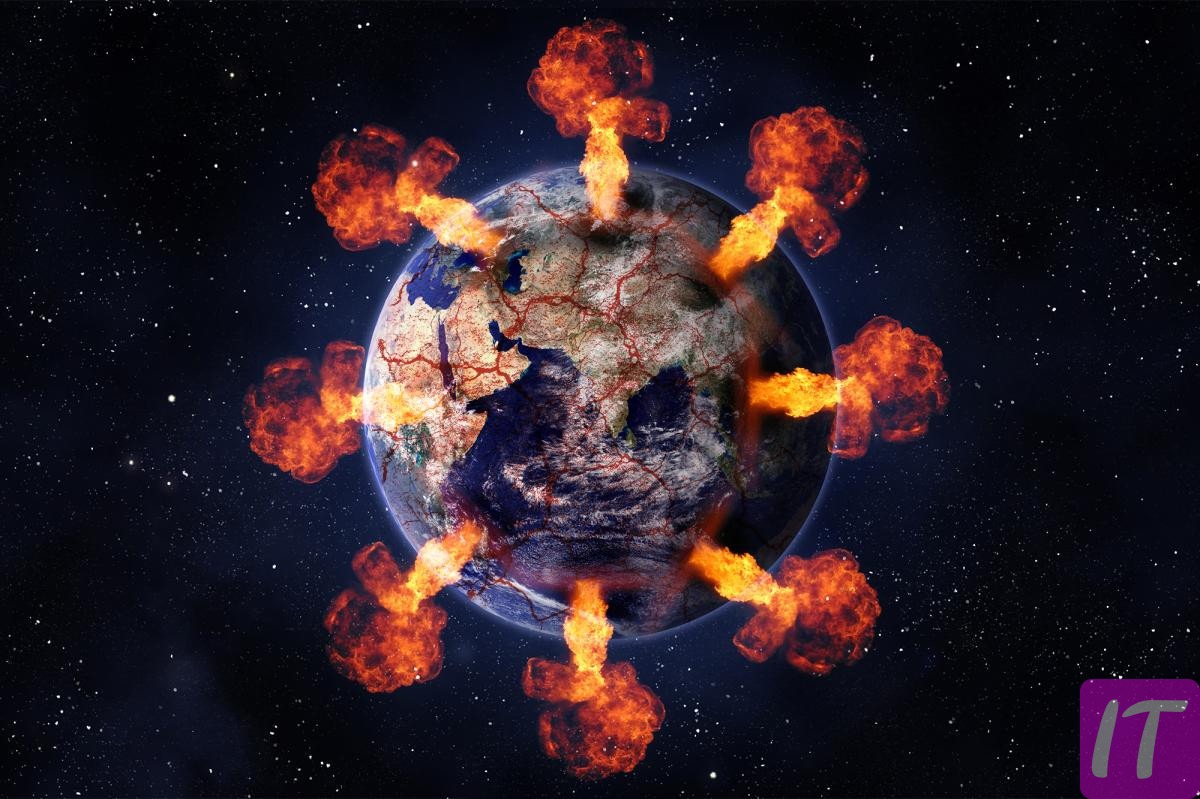It’s staggering to realize that humanity has amassed enough nuclear firepower to obliterate our planet multiple times over. A single modern nuclear warhead possesses the destructive force to annihilate a metropolis, yet thousands remain in arsenals worldwide. This raises an unsettling question: how many times can we actually destroy Earth with the existing nuclear stockpile?
Historically, the Cold War era saw the buildup of nuclear arsenals to such extent that estimates suggested the ability to destroy the planet several dozen times. Today, while efforts have been made to reduce these arsenals, global inventories still hold approximately 13,000 nuclear weapons. This number, though reduced from the peak, still indicates a capability to destroy all human civilization many times over, highlighting the ongoing existential threat posed by these weapons.

How many times do nuclear weapons have the power to destroy the entire earth?
The immense power contained within nuclear weapons is almost beyond comprehension. Today’s nuclear arsenals, though smaller than during the Cold War, consist of thousands of warheads. Each of these warheads has the potential to devastate entire cities. When adding up all the current nuclear weapons, some experts estimate that they could destroy human civilization multiple times. This stark reality underscores the extreme danger these weapons pose.
During the height of the Cold War, both the United States and the Soviet Union accumulated enough nuclear weapons to obliterate the planet several dozen times over. This period of extreme tension led to the stockpiling of over 70,000 nuclear warheads globally. Today, the number has been significantly reduced. However, approximately 13,000 nuclear weapons are still in existence worldwide. Despite reductions, this number remains alarmingly high.
Consider this: a single modern nuclear bomb can be up to 3,000 times more powerful than the atomic bomb dropped on Hiroshima. The combined destructive potential of all existing nuclear weapons is mind-boggling. We live in a world where just a fraction of these weapons can cause catastrophic climate impacts, leading to a “nuclear winter.” Understanding this helps grasp the severe ongoing threat to our planet.
Efforts have been made over the years to negotiate disarmament treaties and reduce the number of active warheads. Agreements like the Strategic Arms Reduction Treaty (START) and the Non-Proliferation Treaty (NPT) aim to limit the spread and reduce the stockpile of nuclear arms. However, the current arsenals still possess enough firepower to end civilization multiple times over. Therefore, disarmament and non-proliferation remain critical global priorities.
Unveiling the Destructive Capacity of Nuclear Arms
Nuclear weapons have a destructive capacity that is almost unimaginable. The explosion from a single warhead can flatten a city in seconds. More than just the immediate blast, the radiation released can cause long-term health issues for survivors. This combination of immediate and lasting damage makes them exceptionally dangerous. Understanding this helps us grasp the true impact of these weapons.
The power of a nuclear explosion is measured in kilotons or megatons. For instance, the bomb dropped on Hiroshima was about 15 kilotons, equating to 15,000 tons of TNT. Modern warheads, however, can range from 100 kilotons to several megatons. Such power can obliterate everything within a vast radius. The shockwaves alone can cause enormous destruction even beyond this range.
The sheer scale of potential destruction is alarming. Consider the Tsar Bomba, the largest nuclear bomb ever tested by the Soviet Union. It had a yield of 50 megatons, which is around 3,300 times more powerful than the Hiroshima bomb. One bomb like that could devastate an entire region, leaving it uninhabitable for years.
In terms of sheer numbers, the current global stockpile of nuclear weapons is staggering. Countries with the largest arsenals include the United States and Russia. Both nations possess thousands of warheads each, contributing to most of the world’s stockpile. Even a small exchange between these nations could lead to catastrophic global consequences.
Historical Perspective: The Nuclear Buildup and its Potential for Global Destruction
The history of nuclear weapons began during World War II with the Manhattan Project. This secret U.S. program developed the first atomic bombs, which were dropped on Hiroshima and Nagasaki in 1945. These events marked the beginning of the nuclear age. The destruction was unprecedented, leading to Japan’s surrender. Nations quickly recognized the immense power of these weapons.
After World War II, the nuclear arms race began during the Cold War. The United States and the Soviet Union competed to build more and more powerful weapons. By the 1960s, both countries had thousands of nuclear warheads. This massive buildup raised the threat of complete global annihilation. The world lived under the constant fear of a nuclear apocalypse.
This period saw the development of even more deadly technologies. Intercontinental ballistic missiles (ICBMs) enabled nations to strike targets halfway around the globe. Submarine-launched ballistic missiles (SLBMs) added another layer of threat, as they could be fired from almost anywhere at sea. The potential for mutually assured destruction (MAD) was very real. It was a time of extreme tension and uncertainty.
Efforts to control the nuclear buildup began in the 1960s. Treaties like the Nuclear Non-Proliferation Treaty (NPT) aimed to limit the spread of nuclear weapons. However, despite these efforts, the stockpiles remained large. The eventual fall of the Soviet Union reduced some tensions, but the legacy of the arms race still impacts global security today. The shadow of nuclear destruction continues to loom over the world.
Current Scenario: Reduced, Yet Alarming Nuclear Arsenals
Today, the number of nuclear weapons worldwide is much lower than during the peak of the Cold War. However, the existing stockpiles are still a significant concern. Around 13,000 nuclear warheads remain across the globe. The United States and Russia hold about 90% of these weapons. This concentration of firepower underscores the continued risk.
Efforts to reduce nuclear arsenals have been ongoing for decades. Treaties like the Strategic Arms Reduction Treaty (START) have played a crucial role. These agreements have led to significant cuts in the number of deployed warheads. Yet, thousands are still poised for quick launch, maintaining a hair-trigger state of readiness. This maintains a constant threat of potential disaster.
Other nuclear-armed nations include China, France, and the United Kingdom. These countries possess smaller arsenals but still contribute to global tension. Additionally, nations like India, Pakistan, and North Korea continue to develop their nuclear capabilities. This expansion adds another layer of complexity to disarmament efforts. The global landscape of nuclear weapons remains precarious.
Modernization programs are another alarming aspect. Both the U.S. and Russia are investing heavily in upgrading their nuclear arsenals. This includes new delivery systems like hypersonic missiles and advanced submarines. Such advancements could make nuclear war more feasible. The new technologies could upset the delicate balance of deterrence.
International efforts toward disarmament face numerous challenges. Geopolitical tensions often hinder progress. For instance, the deteriorating relationship between the U.S. and Russia complicates treaty negotiations. Additionally, the rise of new nuclear states adds to the difficulty. Global cooperation is essential but not easily achieved.
The existence of these arsenals, despite reductions, signifies a perpetual threat. Nuclear weapons have the power to cause massive destruction. The urgency for further reductions and stricter controls remains high. Continued vigilance and international cooperation are crucial for a safer world.
The Ongoing Existential Threat: Understanding the Magnitude of Existing Capabilities
The remaining nuclear arsenals have the power to cause unparalleled destruction. Even with fewer warheads, the threat is immense. Each warhead is capable of destroying entire cities. The global arsenal still holds enough firepower to devastate the planet many times over. This reality keeps the danger ever-present.
Modern nuclear weapons are highly sophisticated. They are more accurate and more powerful than older versions. Advanced delivery systems like intercontinental ballistic missiles (ICBMs) and submarine-launched ballistic missiles (SLBMs) increase their reach. Some countries are developing hypersonic missiles, which travel faster than the speed of sound. Such advancements make the threat even more severe.
The concept of mutually assured destruction (MAD) still looms large. This idea that a full-scale nuclear war would lead to the annihilation of both the attacker and the defender helps prevent conflicts. However, the existence of these weapons means mistakes or unforeseen events could trigger catastrophic outcomes. The risk remains dangerously high.
Attempts to reduce these threats include various disarmament treaties. Agreements such as the New START aim to limit the number of deployable nuclear weapons. However, the complete elimination of nuclear arsenals seems distant. Ensuring the survival of humanity requires continued efforts in diplomacy and arms control.
The danger is not limited to just the immediate explosions. Nuclear detonations can cause long-lasting environmental damage. The concept of a “nuclear winter” describes how massive fires from nuclear blasts would send soot into the atmosphere, blocking sunlight. This could lead to drastic climate changes, affecting agriculture and leading to widespread famine.
The ongoing risks from nuclear weapons are a pressing global issue. Awareness and education about these threats are critical. Continued dialogue and international cooperation play essential roles in managing these risks. The goal remains to achieve a world free from the shadow of nuclear devastation.
Discussing Disarmament: Preventive Measures and Global Pacts
Efforts to reduce the threat of nuclear weapons involve various disarmament treaties and global pacts. Many of these agreements aim to limit the number of nuclear warheads countries can possess. One significant treaty is the Non-Proliferation Treaty (NPT). It was created to prevent the spread of nuclear weapons and promote peaceful uses of nuclear energy. The NPT has been signed by 191 countries, making it one of the most widely supported disarmament treaties.
Another important agreement is the Strategic Arms Reduction Treaty (START). This treaty mainly involves the United States and Russia, the two nations with the largest nuclear arsenals. START aims to reduce the number of deployed strategic nuclear warheads. The most recent version, New START, was signed in 2010 and extended in 2021. It aims to limit each country to 1,550 deployed nuclear warheads.
Some countries have called for a complete ban on nuclear weapons. The Treaty on the Prohibition of Nuclear Weapons (TPNW) is one such agreement. First adopted in 2017, this treaty makes it illegal to develop, test, or use nuclear weapons. Although none of the nuclear-armed countries have signed it, the TPNW represents a significant step toward total disarmament. It reflects the global desire to eliminate these deadly weapons.
Preventive measures also focus on non-proliferation to stop new countries from developing nuclear capabilities. International organizations like the International Atomic Energy Agency (IAEA) play a key role. They conduct inspections and monitor compliance with treaties. These efforts work to ensure countries honor their disarmament commitments.
In addition to formal treaties, other measures focus on securing existing nuclear materials. Initiatives like the Nuclear Security Summits aim to prevent nuclear terrorism. These meetings bring together world leaders to discuss ways to secure nuclear stockpiles. Enhanced security measures reduce the risk of nuclear materials falling into the wrong hands.
Global cooperation is crucial for the success of disarmament efforts. Countries must work together to create a safer world free from the threat of nuclear war. By honoring treaties, taking preventive measures, and participating in international organizations, nations can make substantial progress. The goal of a nuclear-free world is ambitious but essential for future generations.

Frequently Asked Questions
Understanding nuclear weapons and their impact is crucial for global security. Below are some common questions and answers to help shed light on this vital topic.
1. What are the immediate effects of a nuclear explosion?
A nuclear explosion results in a massive blast that can destroy buildings, infrastructure, and lives instantly. The intense heat produced by the explosion causes fires, resulting in further damage.
Radiation from the blast also poses severe health risks, including acute radiation sickness and long-term cancer risks. These immediate effects make nuclear explosions extremely devastating.
2. How does radiation from nuclear weapons affect human health?
Radiation from nuclear weapons can cause both short-term and long-term health issues. Short-term exposure leads to radiation sickness symptoms like nausea, fatigue, and hair loss.
Long-term exposure increases the risk of cancers, such as leukemia and thyroid cancer. Environmental contamination can also lead to birth defects in future generations.
3. Which countries currently possess nuclear weapons?
The primary nations with nuclear arsenals include the United States, Russia, China, France, and the United Kingdom. Other countries like India, Pakistan, North Korea, and Israel also have developed these powerful weapons.
This global distribution adds complexity to disarmament efforts as each country has different policies and levels of stockpile readiness. Maintaining transparency is crucial for global peace initiatives.
4. What measures exist to prevent nuclear proliferation?
The Nuclear Non-Proliferation Treaty (NPT) is a key international agreement aimed at preventing the spread of nuclear weapons and promoting peaceful use of nuclear energy. Signed by 191 countries, it has significantly impacted global disarmament efforts.
The International Atomic Energy Agency (IAEA) monitors compliance with these treaties through inspections and verifications. These preventive measures aim to curb new entrants into the group of nuclear-armed states.
5. What is mutually assured destruction (MAD), and how does it prevent war?
Mutually assured destruction (MAD) is a doctrine where two opposing sides possess enough firepower to destroy each other completely in case of a conflict. This keeps either side from initiating an attack due to guaranteed mutual annihilation.
This concept has historically helped maintain an uneasy peace during periods like the Cold War between U.S.A & USSR (now Russia). It remains a significant factor in modern-day deterrence strategies among nuclear-armed nations.
Conclusion
The persistent threat posed by nuclear weapons highlights the need for global cooperation and vigilant disarmament efforts. While stockpiles have decreased, the remaining arsenals still have the capacity to cause unprecedented destruction. Continued dialogue and treaties are essential to mitigate these risks.
Understanding the magnitude of the existing nuclear threat underscores the urgency for preventive measures. Nations must remain committed to transparency and reduction for a safer future. The ultimate goal remains a world free from the shadow of nuclear devastation.







